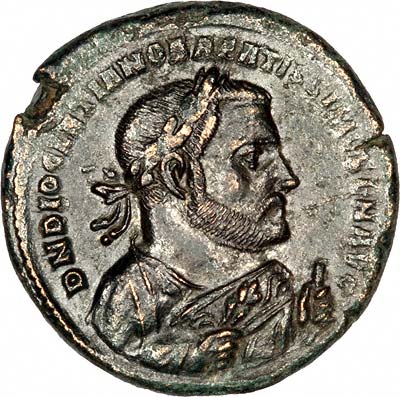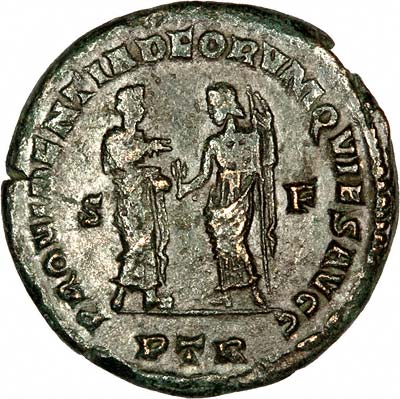| The Very Highest Quality Roman Coins... |
| Roman Coins |
|
| |

| |
|
| |

| |
|
Reverse of Diocletian Commemorative Follis |
Political Reform
Diocletian quickly came to the conclusion that the Roman Empire was simply too big for one man to rule alone. To this end, he appointed his friend and comrade in arms Maximian as co-emperor in 286. Diocletian considered his junior partner to be the superior general, and charged him with the military responsibilities of defending the Empire's borders from barbarian incursions and crushing would be usurpers and rebels whilst Diocletian himself focused his efforts on administrative affairs.
Amongst his administrative reforms was his restructuring of how the Empire was governed at the provincial level. He attempted to seperate military from civil power by making those with military responsibilities dependent on a seperate civil authority for funding their activities. In addition, Diocletian created a Tetrarchy, in which two senior emperors (Augusti) ruled in the East and West respectively and each appointed a junior emperor (Caesar) to share to burden of governance and to act as an heir to their Augustus should he die or retire, wherepuon they in turn would become Augustus and appoint their own Caesars.
Although Diocletian was concerned with seperation of power at the local level, Diocletian abandoned all pretense that the Empire was in any sense a republic (a 'politically correct' fiction which had been maintained since the reign of Augustus) it was now stated quite plainly that the Emperor was a royal despot, chosen not by the Senate or the People of Rome, but by the Gods (although in practical terms, the Army probably still had more say than the Gods in this matter!) Thus under Diocletian and Maximian, the governance of the Roman Empire moved from the Principate Model to the Dominate Model that was to last for the rest of the Empire's existance. The former implied that the Emperor was a first amongst equals, the latter implied that the relationship between the Emperor and his subjects was equivilent to one between a master (dominus) and his slave.
Coinage Reform
In terms of the coinage, the old, hyperinflated and debased Antoninianus was replaced with the follis and its fractions*. Upon their introduction, these were quite substantially sized bronze coins coated in a silver wash. Inflation remained a problem however, and despite Diocletian issuing a price edict which prescribed harsh punishments for those selling goods at more than the decreed maximum price, prices continued to rise and the new currency was also debased and reduced in size over the years.
Retirement and Death
In spite of the ultimate failure of Diocletian's reforms, at the time they brought a considerable improvement to the stability and viability of the Empire during his reign. In an act which seems to have demonstrated a rare and genuine display of a desire to act for the public good, Diocletian abdicated in 305, and compelled his colleague Maximian to do likewise. He had hoped this would start a tradition whereby power would be transfered from one emperor to another peacefully, allowing a younger man to bear the burdens of power whilst his predecessor enjoyed a peaceful retirement. However, things did not turn out as he had envisaged, even within his own lifetime. He lived to see the Tetrarchic system he had devised collapse into the power-struggles and civil warfare it had been designed to avoid as Diocletian's successors squabbled amongst themselves for supreme power. In spite of this, Diocletian was never persuaded to come out of retirement and resume the purple in order to try and restore some semblance of order, even in the face of pleading from some of those putting the idea to him. His comment that he prefered growing cabbages in his own garden to the burdens of imperial rule suggested that unlike Maximian, he wasn't even seriously tempted to heed their plea to return to power, although he did attend a conference called by Galerius in a failed attempt to settle the issue. After this, he returned to his retirement palace in Split, Croatia and died as a private citizen there in 311 A.D.
The featured coin is a scarce Bronze follis struck in honour and commemoration of the former emperor Diocletian following his abdication in 305. It was struck at Trier, in what is now modern-day Germany.
*Unfortunately, little is known about the names of the lower denominations of late Roman coinage. The name 'follis' for this type of coin is, as with the antoninianus, a name that has been applied retrospectively by later numismatists and historians. The actual name of this denomination used by contemporary Romans who circulated these coins is unknown and in the absence of adequate historical evidence, can only really be speculated.
Price & Availability:-
| Description | Grade | Price £ | Price $ | Availability |
| Bronze Follis 7.4g | GVF/AVF | £85 | $Ask | Yes |
Roman Historical Notes
You may wish to visit our Roman Coins. Although it is not complete, we add new and better coins when we can. We are always keen to buy superior quality Roman coins to upgrade our photo gallery.
Order Form - UK
Order Form - USA
Order Form - EU
Order Form - Rest of World
Buying Coins
We also buy coins, please see our We Buy Coins page.
If you want to find the value of a coin you own, please take a look at our page I've Found An Old Coin, What's It Worth?
| ...at the Lowest Possible Price |
|
32 - 36 Harrowside, Blackpool, Lancashire, FY4 1RJ, England.
Telephone (44) - (0) 1253 - 343081 ; Fax 408058; E-mail: enquiries@24carat.co.uk The URL for our main page is: https://24carat.co.uk Web Design by Snoop |